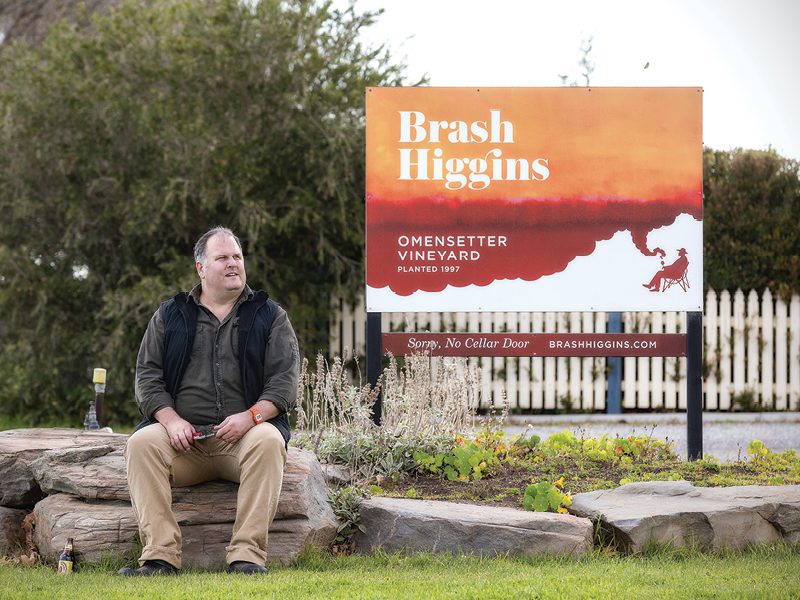
Meet Brad Hickey, aka Brash Higgins, the New York City somm turned McLaren Vale winemaker with a thing for alternative wine styles.
It’s a brisk autumn afternoon in McLaren Vale. A group of pruners gather around a fire, gnarly fingers held above the flames. The motley crew of drifters, expats, and Fleurieu Peninsula locals chew the fat over plastic bowls full of steaming Jambalaya. They have weathered skin, an eye for detail, and cause for celebration. Pruning season is nearly done for the year. It’s been a cold one and they’re looking forward to a breather. At the centre of the rabble is Brad Hickey, aka Brash Higgins, the towering Yank behind Brash Higgins Wine Co. As Brad fills wine glasses, his partner in life and business Nicole Thorpe dishes out homemade cream buns and smiles.
“It’s the annual barbecue for the pruners,” Brad says. “They’re a surly bunch.”
The mood is jovial. He grins. “These are the same guys I worked with when I came to Australia so it’s kind of ironic: they say ‘you bastard, we taught you how to prune and now you’re lord of the manor.’”
It’s actually more giant shed than manor. Here, on 20 acres of land, 17 of which is under vine, Brad and Nicole mess with tradition. In 2016 the Brash Higgins nero d’avola won the Rule Breaker award at the SA Hot 100 wine show. Grafted to the Omensetter Vineyard in 2009, the fourth vintage of the drought tolerant Sicilian varietal was picked at 13.5 Baume in 2014.
“We set the tone straight away,” Brad says, “and put in a grape variety that no-one in the Vale had planted. Commercially, in Australia, there’s only one clone of nero d’avola. The Chalmers’ folks brought those first nero cuttings over from Sicily, God bless them, and we were first in line in 2009 when they became available.”
So, how did this American establish roots on Aussie soil? As back-stories go, Brash Higgins’ is a cracker. Before making wine he poured it as a sommelier in some of New York City’s swankiest, Michelin-starred restaurants.
If he had time, Brad could do a fine job of penning his life story. The former English Literary and Botany graduate grew up in the northern suburbs of Chicago Illinois, the town where John Hughes shot movies The Breakfast Club, Sixteen Candles, and Ferris Bueller’s Day Off. Like the stars of the eighties classics filmed on the streets around him, the teen dreamed of better things: like writing the next great American novel. Instead, he moved to France.
“I went to Paris at 20, right after university,” he says. “I had one connection there… someone I used to play soccer with.” Armed with nothing but a floor to crash on, he crossed the pond to chase Parisian dreams.
A culture shock awaited. “I remember the loneliness of being a young non-French speaking person in Paris. Every time I opened my mouth people realised I was American. ‘He’s American and he can’t speak French, why is he here?’”
His first job on Parisian turf was as bus boy at burger/rib joint Chicago Meatpackers. When he wasn’t earning a crust, he was spending it travelling (hitchhiking) across Europe. During his year-and-a-half abroad he grew a serious set of bollocks. “I remember the growth more than anything. And being afraid so often. You’d have to suck it up and go in to situations where you were scared. It taught me a lot about self reliance and what I was capable of.”
After returning to the US in 1991 Brad travelled the country looking for a place to settle. “I wanted to find a place I was happy living in before finding the work that made me happy.”
He chose Portland, Oregon, and spent
six years getting around by bicycle, working at a plant nursery and running his own residential landscape design company.
At 27 life started feeling too comfortable.
So, he moved to New York.
“I had friends working in glossy magazines there and writing for Spin magazine and Details. I wanted to try to crack the scene.”
In reality, freelance writing was a tough market. To “stay alive” Brad worked in restaurants. “Union Square Café was one of the hardest jobs I ever applied for. I was in a great restaurant town and didn’t want to just work anywhere so thought I might as well shoot for the top.” He was hired after seven trials. “Classic New York City.”
Union Square Hospitality Group’s chief executive and restaurateur Danny Meyer also ran the likes of Gramercy Tavern, Shake Shack, The Modern, and Café 2 and Terrace 5 at MoMA. “I could see how serious they were about it and that made me take it seriously. It wasn’t just a shit job. There were people working there who had been there many years and had other careers as opera singers. They did other things with their lives but stayed working there because they were treated with respect. Management gave everyone the power to do what you needed to do to get the customer out the door happy.”
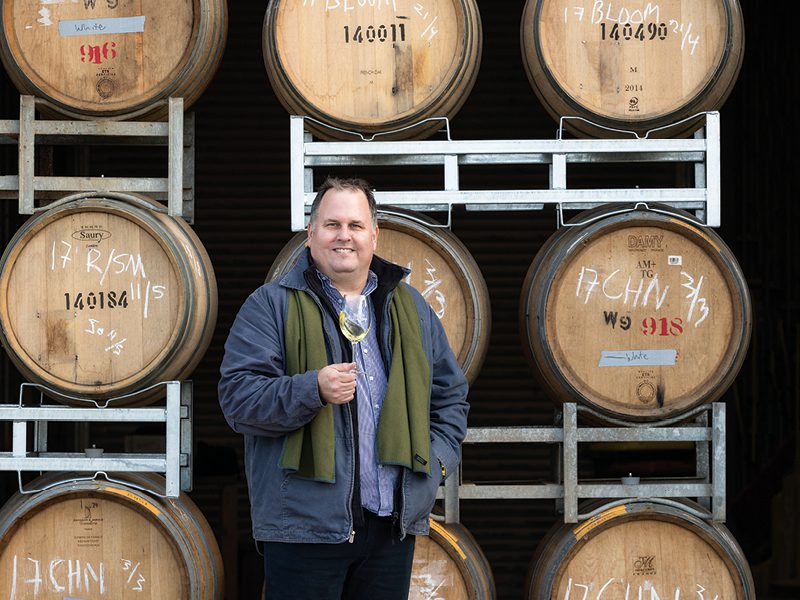
He began to see potential in a career in wine. “The wine program there was strong and fairly priced. It was full of interesting selections and the wait staff could act as sommeliers so there was a lot of room to explore that.”
It turned out to be one of the most highly sought after positions in New York. “The money was really good and the place was busy all the time. It was loaded with celebrities and people in publishing because it was right next to Faber & Co and Farrar, Straus and Giroux. The lunch scene was all about publishers and writers.”
Brad gave writing aspirations the flick and focused his attention on wine.
“I had to make a decision. I was in my thirties and had to focus on one thing and do it really well.”
A position as a cellar rat at four-star restaurant Lespinasse gave him the leg-up he needed. It was in the St Regis Hotel – a glamorous place full of hoi polloi, tuxedos, and a Louis XIV dining room. Brad was cast down to the cold, wine-packed dungeon. “I sucked it up for two years, earned less and went into debt but after working in a four-star environment doors started opening.” Now a sought after young somm, Brad went on to work for French culinary genius Daniel Boulud at Cafe Boulud, then as as wine director for David Bouley’s Bouley, Danube, and Bouley’s Test Kitchen. “Bouley was the crowning glory of my somm career.”
Brad had no aspirations to be a Master Somm. “I knew in the back of my mind I wasn’t going to open my own restaurant or be on the floor of a restaurant for the rest of my time so I kept studying on my own and learnt what I needed to know.” He resists the idea of requiring an encyclopedic knowledge of a subject before practising it. “France helped me realise that education is amazing for building some kind of conceptual knowledge but most knowledge comes from experience.” Instead, he makes a habit of working with the best people he could, which led to the next chapter: Australia.
Brad fell in love with McLaren Vale during a sommelier junket in 2004. “That was one of the amazing things about working for a three star Michelin environment… you were on everyone’s list to go places and could select wherever you wanted to go: Burgundy, Champagne, Australia, and South Africa… but I particularly loved McLaren Vale. I remember saying ‘geez, I want to come back here’. It was the prettiest place, the air was clean, and it was so beautiful.”
After four years in Bouley’s pressure-packed, fast paced restaurant environment, he quit.
“There was a period there where I didn’t know what I was going to do. I didn’t want to go into sales or education. I wanted to get more involved in production.”
Winemaker Chris Ringland suggested working vintage in Oz. “I thought that was perfect. I’d spend three months in Australia, and maybe get a chance to see what I wanted to do next.”
He was 39. “My parents were definitely worried.”
A decade later, Australia is home. Brad met Nicole by chance during knock off drinks at Willunga’s Alma Hotel. After a lengthy period of VISA dodging, love blossomed and the pair applied for a partner VISA. They haven’t looked back since.
“Nicole is a really amazing, strong, organised businesswoman. She doesn’t take shit from anybody which is very impressive to me. I hadn’t met a woman like that. She was willing to stand up to me and tell me to shut the fuck up. She’s definitely not sheepish.”
After the death of her husband Craig in 2005, Nicole was simultaneously running the family’s drilling business, raising her children, and managing her wine label Thorpe Wines. “Nicole and Craig planted the vineyard and did everything themselves,” Brad says. “It’s pretty impressive.”
Thorpe Wines was in production since 2003 but after the death of Craig, Nicole had little time to focus on the wines. When Brad met Nicole four years later she was swamped. He offered to help shift some of the product and learn more about the Australian market. “I didn’t have any grand plans of making wine,” he says. “I knew I could talk the talk. We eventually sold everything under Thorpe Wines but had to sell it at a discount. It bastardised the brand. It wasn’t a road we wanted to continue going down. If you keep making wine that way and selling it for $10 a bottle you’re robbing Peter to pay Paul.
We knew we needed to think about another story and brand.”
The vineyard was producing A-grade fruit and Brad was becoming more involved in the vineyard and winemaking. Thorpe Wines was making shiraz and cabernet with Tim Geddes at a contract winemaking facility. “It was great to go and work there and see the everyday operations of how he managed the big facility. Also to deal with the whole vintage and how the flow works in a winery.”
Impatient with the focus on shiraz and cabernet, Brad started experimenting. “The idea of doing something a bit different was appealing. We removed shiraz from a little half-acre block which wasn’t considered very wise in a shiraz district.”
They started working with amphora and making nero d’avola. Brad left it on skins for six months and jury rigged their own lids. “It was my little pet project.”
A few barrels of riesling/semillon followed. “I eked out a little space in the winery that would work on that one. The grenache/mataro was another early idea. Just a two-tonne type deal.”
He added more amphora to the mix and things got crowded. “In 2013 we put the amphora in our garage and made the ’13 vintage in our carport. We realised we needed to start thinking about our own facility and started drawing a line in the sand out here in the shed to store our dry goods and boxes, and labels. We then designed a way to build a small micro-winery in there. We tapped in to the big wash bay that was already there. All of a sudden what was a confined space became something that was actually manageable for what we wanted to do: 3000 cases.”
The name, Brash Higgins Wine Co is based on Brad’s alias. “It was the nickname the pruners gave me. One that stuck. Everybody calls me Brash, especially around here. Or bastard.”
Nicole is happier behind the scenes than she is in public eye but the name was chosen to encapsulate both back stories. “It’s not just my story… it’s a story about a person who moves and transforms.”
2014 was Brad’s first vintage in his own facility. He produced nero d’avola, zibibbo, riesling/semillon and grenache/mataro in his own space.
“It was a steep learning curve.”
His limited technical background has been a blessing in disguise. It gave him freedom to work on instinct, flavour, common sense, and creativity. “There was nothing boxing me in. I’m not a technically trained winemaker so I was looking at wine in a different way than someone who may have done heaps of chemistry. It’s not that common to co-ferment semillon and riesling but why wouldn’t it work? It’s like cooking dinner… we should be able to make something interesting from these flavours.”
Quality fruit is essential. “People always say it’s made in the vineyard and the less interference the better. If I can get something in the glass that’s really delicious and tastes authentic then why would I want to interfere? We’ve tried our best to not interrupt the process. You still have to make very important decisions along the way but learning to be hands off has been pretty important to our style of wines.”
Brad is driven by curiosity. “My first instinct is ‘what can I do with these grapes?’ From there, if we like the fruit from a vineyard, the battle is almost half over. We have now a place where we can execute ideas. If I have a vision about something I want to do, I can make it happen. It’s pretty exciting to have the control of that. This setup means we’re self-reliant.”
To date, Bash Higgins boasts 28 amphora (made by Bennetts Magill Pottery) and 14 wines.
“It’s pretty straight forward. I’m usually not going to double up on things. If I’ve got one grenache I’m not going to do two. We want what we’re making to be a contributing member of the family.” He also looks for a point of difference. “It’s quite easy for us to make a big, powerful red wine in this district so it’s always more exciting to find ways to make more medium bodied, approachable, lighter reds.” The five whites are different, too. “Whether it’s an oxidated wine like Bloom to something like a chenin blanc which is very dry, or a zibibbo which is really funky, full of skin contact and done in an amphora: each one of those wines tells a different story. That’s got to be something I consider before I’ll commit to growing something or purchasing fruit from somewhere else – does it actually make sense?”
Mataro is the latest addition. “It’s probably going to take away from some of the sales of my other wines because not every restaurant is going to carry your whole range. Part of me always wonders whether adding new wines to an already existing family of wines is intelligent. Again, this is the stuff that makes me get excited. I think there’s room for that. I don’t think you necessarily need to discontinue something to bring something else in. We’ll be doing our first rose this year which again will be something different. It’s cinsault and carignan.”
Volume-wise, Brad is happy with around 3000 cases. “I wouldn’t want to make more than 4000. That’s manageable. We’re growing into the US and Canada a little bit, and southeast Asia up into Singapore.”
Brad does the digital marketing side of things (primarily Instagram and Facebook) himself but isn’t a fan of big noting the brand. “I like to keep my nose to the grindstone and work, then show new wines and hopefully that’s how we can captivate people.”
Brash Higgins HQ doesn’t have a cellar door. Tastings are in the shed and by appointment only. There is no fee. “People are stoked when they meet the winemaker. When you go to a cellar door and it’s someone else behind a counter it’s a good experience but not the same as meeting someone who is directly involved.”
The great American novel is on hold for now. He’s happy telling stories through his wine.
“In a lot of ways it is an extension of who I am. There’s never a moment where Nicole and I say ‘this is a wine we both really dig but we’ll never be able to sell it’. It never crosses my mind. I know I can sell something I believe in.”
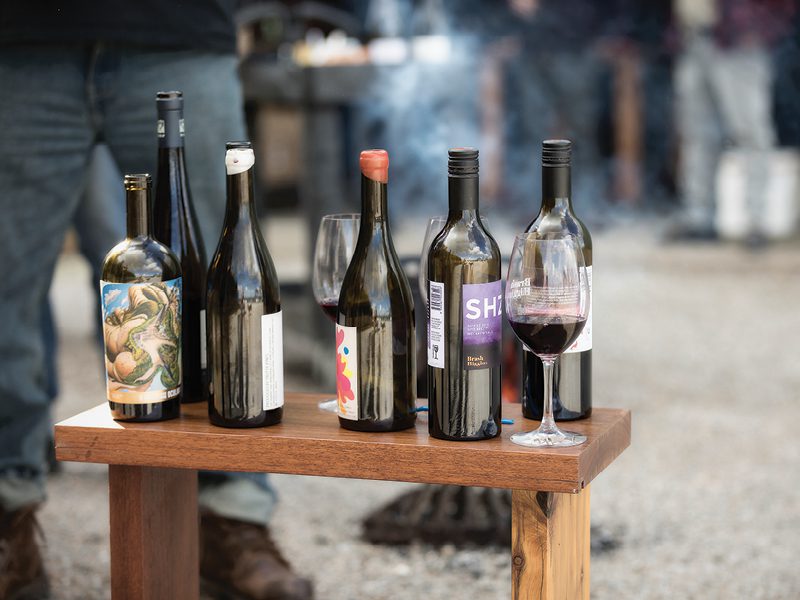
The Labels
The basic Brash Higgins template was designed by Swear Words design studio and is based on simple but modern, bold, abbreviations and colour. “The labels were designed around the idea of airports, travelling, and airport locators. So SHZ, GNV (Geneva), and SFO (San Francisco). They almost have a table of elements feel to them.” Artists were also added to the mix. The label for Nymph features a painting by Alesandro Ljubicic, a Bosnian-born painter based in Sydney. The latest Mataro (MATO) was designed by New York artist and graphic designer Kara Van Woerden.
The Crystal Chapter
Greek variety crystal is next on Brash Higgins’ horizon. “We should hopefully have the first crop – at least a small one this year. It’s an enormously obscure grape and that’s the beauty of it. Historically it has been used in Greece to make ouzo. We got it from the backyard of a Greek guy who bought it from his hometown. He’s been here 60 or so years. We weren’t sure of the origins of the grape so sent a cutting off to France where the largest library is – they came back and said ‘yes, it’s 100-percent crystal. The grape is originally from China and then 500 years ago it made its way to Greece. We’ve got four rows: 80 plants, enough to make maybe 30 to 40 cases of something.” What will he make? “That’s a question mark. It’s a cross between vinifera and lambrusco so the grapes sometimes from those sort of pairings… it’s not straight vitis vinifera but lambrusco can sometimes add a foxy aromatic to it. We’ll probably pick on the dry side … it’d be really tempting to make something with bubbles.”
Photos: Ben Macmahon
• This article first appeared in the September/October edition of WBM – Australia’s Wine Business Magazine. To subscribe visit www.wbmonline.com.au




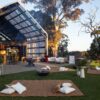


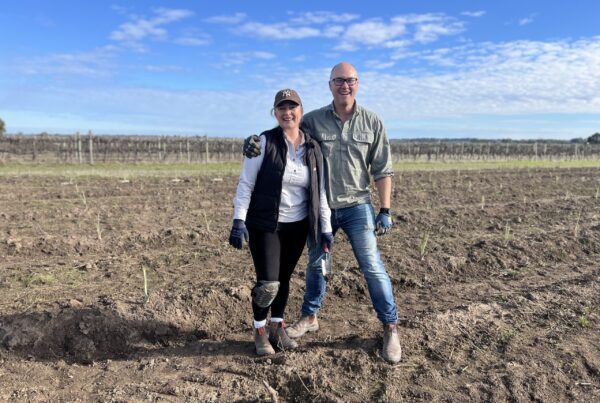
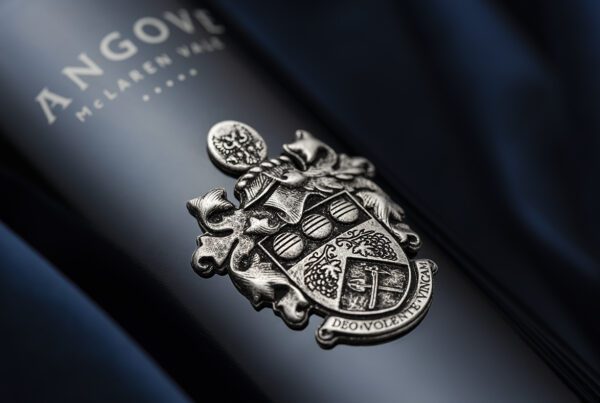
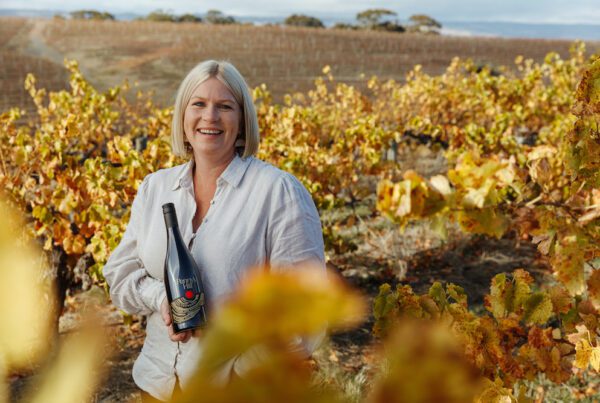
Recent Comments